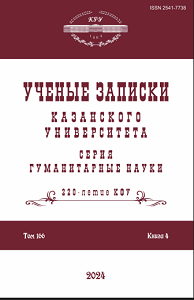Достижения археологов Казанского университета в контексте западноевропейской и североамериканской археологии
Archaeological Research at Kazan University in the Context of Western European and North American Archaeology
Author(s): Konstantin Aleksandrovich RudenkoSubject(s): Archaeology, Education, Cultural Anthropology / Ethnology, Higher Education , Sociology of Education
Published by: Казанский (Приволжский) федеральный университет
Keywords: Kazan University; Ananyino culture; Volga Bulgars; Bilär settlement; A.M. Tallgren; V.F. Smolin; A.Kh. Khalikov; G.A. Fedorov–Davydov; G. Mako; F. Curta; archaeological research; Society of Archaeology; History; and Ethnography at Kazan University;
Summary/Abstract: This article summarizes the history of archaeological research at Kazan University, from its establishment in 1804 to the present day. The first important milestone was in the 19th century when amateur collecting of artifacts and coins by the university professors in the early 1800s was replaced by professional archaeology, with the Society of Archaeology, History, and Ethnography founded in 1878 at Kazan University. The society published its own journal to raise awareness and foster curiosity, both locally and internationally, about archaeological discoveries in the Kazan Governorate and the surrounding territories. From the late 19th to the early 20th century, a fruitful cooperation developed between Russian archaeologists and Finnish scholars, which lasted until the 1930s and centered in their mutual interests revolving around the Ananyino culture and the origins of the Finno-Ugric peoples. In the aftermath of World War II, the university archaeological team took part in many projects: exploratory surveys for the construction of the Kuybyshev Hydroelectric Station (late 1940s–early 1950s), excavations of the early Bulgarian burials and proto-Bulgarian sites (1950s–early 1960s), unearthing of the Bilär settlement (late 1960s–1980s), fieldwork at the ancient Hungarian Bolshie Tigany burial and in Kazan (1974–1978). In the 1960s–1980s, foreign collaborations were limited to socialist countries (Bulgaria, Hungary), which kept the focus of their scholarly attention on the eastern regions. However, the intensive contacts with Finnish archaeologists continued. Starting from the 1990s–2000s, the results of archaeological research in Tatarstan finally became accessible to Western European and US scholars, who then relied on them to navigate their studies on the history of Islam and Islamization in Europe, sedentarization of nomads, and medieval trade. Now, the archaeology at Kazan University has advanced to a new stage by covering a much broader geographical scope and incorporating the latest technology into archaeological practices.
Journal: Ученые записки Казанского университета. Серия Гуманитарные науки
- Issue Year: 166/2024
- Issue No: 4
- Page Range: 77-93
- Page Count: 17
- Language: Russian

